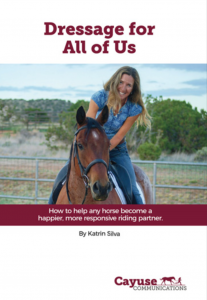
Katrin Silva is the author of Dressage for All of Us
Editor’s Note: Best Horse Practices Summit presenter Katrin Silva grew up riding dressage in Germany before moving to the United States at age 19 to learn to ride Western. She’s been riding both disciplines for the last 20 years and is a regular guest columnist for Cayuse Communications. The author of Dressage for All of Us: How to Help Any Horse Become a Happier, More Responsive Riding Partner and the forthcoming Ride with Feel: A Guide for the Rest of Us lives in New Mexico where she works with dressage and Western clients.
Katrin Silva writes:
“I feel guilty when I tell my horse to do something.”
“I don’t want to be harsh.”
“I don’t want to ruin my positive relationship with my horse.”
“I want to be in harmony.”
“I only want to use positive reinforcement.”
These comments come up a lot when I work with my students. My reaction is an odd mix of appreciation and frustration, a simultaneously vigorous nod and head shake. I can’t completely agree with their reasoning, but I do know where they come from.
Here are things I want to say, but usually can’t find the words for during a lesson:
“Thank you for considering your horse’s point of view. It’s a positive change from the kind of comments I used to hear a lot more of, from trainers I worked for and also from students I taught years ago. Comments like:
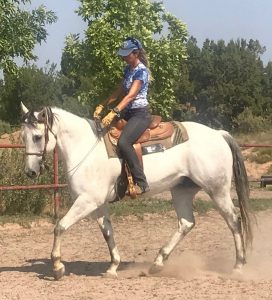 “He is so stubborn, I need to get after him.”
“He is so stubborn, I need to get after him.”
“I have to use rock-grinder spurs and a twisted-wire snaffle, or he won’t do what I want him to do.”
“I need to show him who’s boss!”
Thank goodness this authoritarian attitude about training horses is on its way out. Our view of horses and their relationship with us is changing, slowly but surely. When I started in the horse business, total obedience was the main goal of training. Getting there often included equipment and methods that caused horses pain, methods that made horses suffer. I am glad we are trying to do better.
I am glad you want to do what is best for your horse. And yes, you are right: light aids and harmony are the goal in any serious pursuit of horsemanship. Every minute you spend fighting with your horse is a waste of time. The only thing a horse learns form fighting is to fight back.
But this doesn’t mean we should go to the other extreme of never asking our horses to do anything, or of not following through when they disagree with us. As long as we are asking for something reasonable and appropriate at the right time, as long as we are sure our horse understands the basic concept of an aid, it’s ok to insist on a response. Following through with a stronger aid for a moment will give you the chance to release and reward at the slightest suggestion of a response. Conversely, the constant repetition of a light aid will deteriorate into nagging and meaninglessness. A constant half-halt becomes meaningless. So does constant prodding with the leg, or constant tugging with the lead rope, or constant clucking with one’s voice. It can be much kinder, in the long run, to use the spur or the whip for a moment rather than repeating a light signal the horse does not respond to.
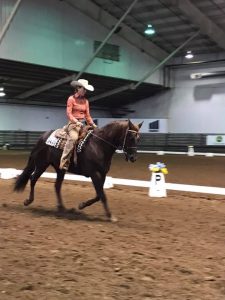 Horses appreciate clarity.
Horses appreciate clarity.
Riders may unwittingly teach their horses ignore them. They have not explained that an aid means something every time. We can’t blame a horse for believing that we want no response at all if we don’t really expect one. We can’t blame a horse for responding to an aid on the 47th time, rather than the first time, if we don’t expect a first-time response. How should he know that it matters?
Of course, you should examine if you’re asking your horse for something that’s appropriate and reasonable. You want to set him up for success, not failure or frustration:
Are you giving your aid in a way your horse can understand?
Are your seat, hands, and legs giving conflicting messages?
This happens a lot when we get carried away practicing a particular movement. We get crooked or quit following the horse’s back with our back. Checking my own position is the first thing I do whenever my horse does not respond promptly.
Are you asking your horse for something he is capable of?
He needs to understand the basic principles of the aids you are giving. If what you asking him to do is too difficult, physically or mentally, you need to break your ask down into smaller pieces.
For example
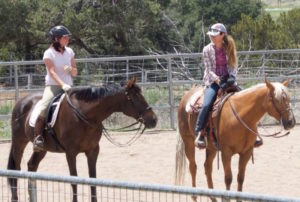 If you are asking your horse for a shoulder-in:
If you are asking your horse for a shoulder-in:
- He first needs to know how to bend around a rider’s leg.
- He needs to know what a half-halt is. He needs to be trusting and focused enough to separate the bending aids from being on a circle.
- He needs to be strong and supple enough to carry more weight on his hindquarters while trotting, at least for a few strides.
These building blocks need to be in place before insisting on the shoulder-in. If he does not understand the bending aids enough, I go back to the 10-meter volte. If he pushes against my inside leg or my outside leg, I go back to the leg yield. If he misunderstands the bending aids and offers to overbend his neck, I straighten him or even counterbend him. If he is not ready to collect his trot, I go back to the shoulder-in at the walk. And if he loses forward momentum, I go back to a straight line in a lively posting trot. And of course, if he gets tense and does not relax back into his work within a few strides, I abandon all thought of the shoulder-in. Instead, I go back to a stretchy trot, a free walk, or whatever else it takes to re-establish relaxation.
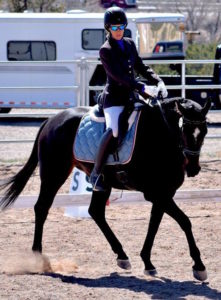 Is what you are asking part of something that will ultimately further your horse’s athletic development or long-term soundness?
Is what you are asking part of something that will ultimately further your horse’s athletic development or long-term soundness?
The beauty of dressage is that the daily work ultimately creates its own rewards: fitness, strength, confidence and being better able to carry a rider for years to come.
If the answers to my questions are YES’s, you shouldn’t feel guilty using a stronger leg aid, stronger half-halt, or other corrective measure. As long as things don’t this deteriorate into a prolonged argument, you can feel good about it.
If you want to feel bad about something, feel bad about nagging, prodding, or tugging for the duration of your ride while both you and the horse become gradually more frustrated.